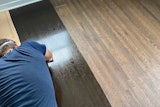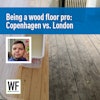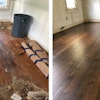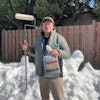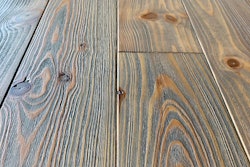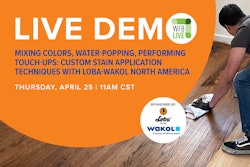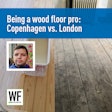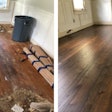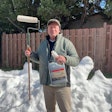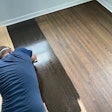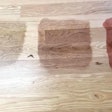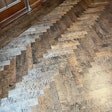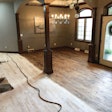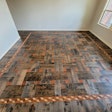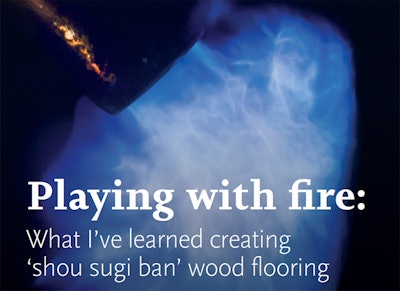
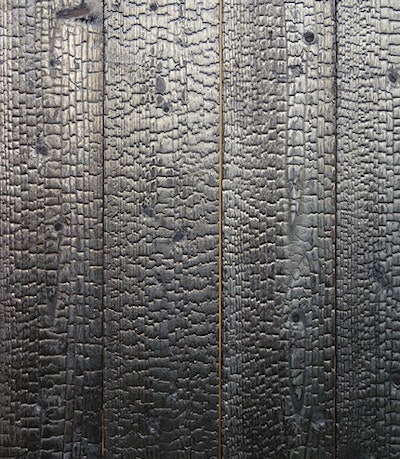 Traditional shou sugi ban siding.
Traditional shou sugi ban siding.
Not long ago, there were probably only a handful of people in the wood flooring industry who knew what "shou sugi ban" was, much less attempted it. Then a video went viral online of a guy "burn-staining" a wood floor with a little propane brush burner. Suddenly thousands more people were aware of "burn-staining," or, what is actually called "shou sugi ban." In October, a contractor and a property owner in Janesville, Wis., actually set a house on fire after "burn-staining" the wood floor—they completed the burn-staining in the afternoon, thinking all was well, and then that evening firefighters responded to a call that the residence was on fire (they determined the fire began in two separate areas due to the burn-staining).
At my company, we've been doing shou sugi ban floors for about three years, and we only do them in a safe environment on flooring that isn't actually installed. I've learned a lot since our first attempt at this technique, and I'm sharing what I've learned here in hopes that my fellow professionals will have a better understanding of what an undertaking a proper shou sugi ban hardwood floor is and the safety requirements.
Shou sugi ban's origins
I first heard of the term "shou sugi ban" probably 25 years ago when I was studying Japanese woodworking. Although I'd learned the wood flooring trade, at that point I was still a hobby woodworker, and my mom had bought me a hardbound copy of "The Soul of a Tree" by legendary Japanese woodworker George Nakashima.
What we call shou sugi ban goes back hundreds of years in Japan and is more correctly known as "yakisugi," or the traditional art of burning Cryptomeria japonica, which is colloquially called cedar but is actually a species of cypress native to Japan. Historically in Japan the process of charring the wood was done for exteriors because it destroys the lignin and cellulose, leaving behind nothing that is attractive to insects, mold or mildew. This is why there are still Japanese temples standing from the 13th and 14th century (or even older) in good condition (see the oldest known standing example, from the 8th century, in the sidebar on this page). Although not commonly done in Japan today, the process is seeing a resurgence in the West.
My first attempts
My first attempts at burning wood flooring happened when I began playing with charring the edges of pieces of inlays just to make them look old. To do that, we heated mason sand with a torch and burned the edges of the wood by sticking them in the sand. We wanted to extrapolate that to some larger pieces, but they wouldn't fit in our container.
Then I had a customer request shou sugi ban on a plank floor. He had samples of shou sugi ban flooring from a European company, but that company didn't produce the plank as wide as he wanted; he was looking for something like an 8-inch live-sawn oak floor. When someone asks me to do something we've never done before, I tend to tell them that sure, of course we do that, and then I go figure out how to do it—which is what I had to do for his floor.
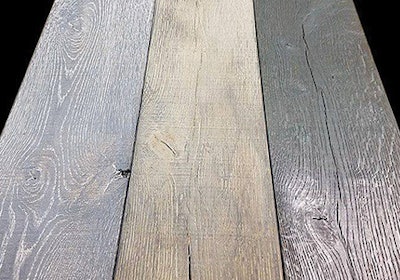 Shou sugi ban on shrunk-face white oak with natural oil three ways (from left): white ceruse, tan pigment and natural.
Shou sugi ban on shrunk-face white oak with natural oil three ways (from left): white ceruse, tan pigment and natural.
The learning curve
We had some trial and error to get something that would work. I started off with a smaller brush burner—just your standard Amazon cheapie version. It had a 6-foot hose, and it quickly became apparent that it couldn't heat the wood quickly enough. By the time I got the char effect, the board was so cupped and twisted you couldn't do anything with it.
Next I got a larger burner with a 20-pound cylinder, but I couldn't maintain the gas flow because my tank was icing over from evaporative cooling. I'd have to shut it down and wait to thaw it out before I could use it again. I probably went through three or four ditch burners until a roofer I know said that I needed the one he has, and he told me where to get it. That burner is what they use for doing seams on bituminous membranes for flat roofs; it's 400,000 BTU with a 100-pound tank and 100 feet of hose. It can throw a 5-foot blue flame!
Once I was at that point, I had to figure out how not to heat my feet up or burn my pants, so I ended up getting firefighter boots and Nomex firefighter pants so I could focus on what I was burning and not whether or not I was burning. With regular steel-toed leather boots you'll find yourself running outside pouring cold water on your feet.
 If you don't heat the surface fast enough and get enough water on the flooring right away, you'll end up with cupped shou sugi ban boards like this one.
If you don't heat the surface fast enough and get enough water on the flooring right away, you'll end up with cupped shou sugi ban boards like this one.
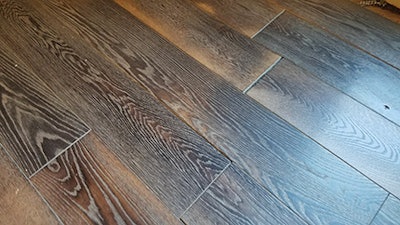 This white oak flooring had a partial shou sugi ban burn, wire-brushing and then a finish process that created this off-white ceruse effect.
This white oak flooring had a partial shou sugi ban burn, wire-brushing and then a finish process that created this off-white ceruse effect.
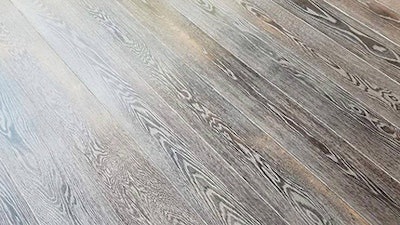 For this white oak floor we did a heavy burn and wire-brushing, then applied white pigmented natural oil.
For this white oak floor we did a heavy burn and wire-brushing, then applied white pigmented natural oil.
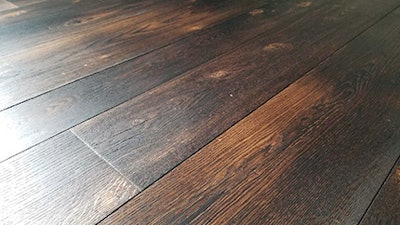 This Mansion Hill Custom Floors project featured 8-, 10- and 12-inch engineered French white oak with a 'medium roast' shou sugi ban. It was wire-brushed and coated with Overmat oil finish.
This Mansion Hill Custom Floors project featured 8-, 10- and 12-inch engineered French white oak with a 'medium roast' shou sugi ban. It was wire-brushed and coated with Overmat oil finish.
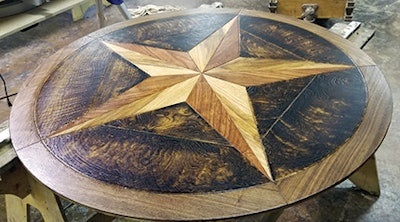 This Texas star medallion used the homeowner's local mesquite and pecan with a walnut frame and shou sugi ban curly white oak for an accent between the star points.
This Texas star medallion used the homeowner's local mesquite and pecan with a walnut frame and shou sugi ban curly white oak for an accent between the star points.
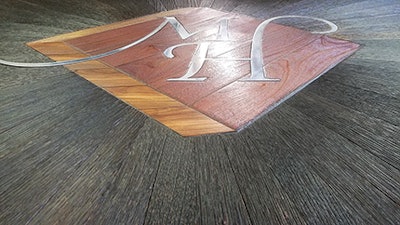 This Mansion Hill Custom Floors mobile showroom floor features shou sugi ban riftsawn white oak surrounding santos mahogany, jatoba and aluminum.
This Mansion Hill Custom Floors mobile showroom floor features shou sugi ban riftsawn white oak surrounding santos mahogany, jatoba and aluminum.
The benefit of having such a hot flame is that the wood gets hot quickly, which means it's really only affecting the surface—you don't have to dwell there to get the effect you're looking for. The faster you can get it done, the less warping, cupping and cracking you're going to have. Also, by now I've done a lot of roasting on wood that is an engineered product with a 4-mm wear layer. If I had to use a smaller torch and linger on the surface to burn the wood, I'd melt the adhesive in the flooring.
I can't tell you how much wood we wasted trying to get the process down, but I can tell you that we made a lot of boards that looked like Pringles.
The artistry of the flame
The process of actually burning the wood is a lot like airbrushing or using a spray gun, and people quickly realize it isn't as easy as it looks. You have to feather one pass into the next and pay attention to what the torch is doing, because otherwise you'll end up with lines of light and dark with no continuity or uniformity. The height at which you hold the torch is critical; you need to hold it three or four feet high so you don't get a concentrated burn right in the center. That gives you the ability to overlap your passes in a way that blends your pattern.
You can't just pass uniformly at the same speed over each board. Grain that is closer together roasts faster than wider, more diffuse grain. End grain darkens much faster, but knots don't burn as fast as the material around them. So the actual burning process is something you're very much doing by eye. I'm usually burning the flooring to match a control sample chosen by the customer. If I go over it pretty quickly I can get a nice, rich chestnut color, and then of course the options go darker from there.
On these jobs, I've racked out all my flooring to roast it. The flooring will be picked back up and reshuffled when it's actually installed in someone's house. This helps blend in darker and lighter areas that naturally happen in the flooring. One thing I think would be very daunting about doing this on an actual job site (besides the obvious safety concerns) would be getting enough uniformity that you don't have clusters of light and dark burn.
Water and wood
When I'm roasting the floor I'm going down the rows and doing an area about as wide as what I could bite off when I'm staining a floor, so maybe 2 to 3 feet wide. It takes me less than a minute to roast a 2-by-6-foot area, and then someone is coming behind me immediately with a big commercial backpack sprayer to extinguish what I've just done. The sprayer we use can probably pump out a gallon or two per minute. You want that person coming behind you as quickly as possible to put out the fire and minimize the cupping and warping effects of the heat on the wood, but not so quickly that you risk getting overspray on the area you haven't burned, which creates a terrible stippling effect.
I think most guys would be taken aback by how much water we use. They think you just can't put that amount of water on wood, but we typically let the wood dry for 24 to 36 hours, and in our experience we've ended up with product that is stable and well-behaved. We use a moisture meter on the wood to check moisture content before and after the burning/spraying.
Next step: brushing and finishing
Once your burning process is done, you have to remove most of the char because it's soft and frangible—think of the wood in your campfire. It would have no wear capability, so we typically do a pretty heavy wire-brushing as our final step before adding any color to the floor. We use the Ceno Satellite that has six 4-inch crimped wire cupped wheels until we stop seeing char come off the floor.
Because we are wire-brushing these floors, I find the species that work best are ones like oak and pine that develop a lot of texture between the springwood and summerwood. The process works on woods like maple and cherry, but they won't result in the same contrast in texture.
Once the flooring is wire-brushed, at that point the floor has a nice roasted look, and we can go from there to many interesting looks we've developed by using natural oils; you don't have to be committed to monochromatic looks or just shades of burn. You can take that charred look and shift it into some interesting grays and pastels and other colors. We'll often use a Rubio precolor or a water-based pigment system before we use colored oils on the floor. The process opens up a wide array of specialty finishes and looks that most pros wouldn't have the ability to do.
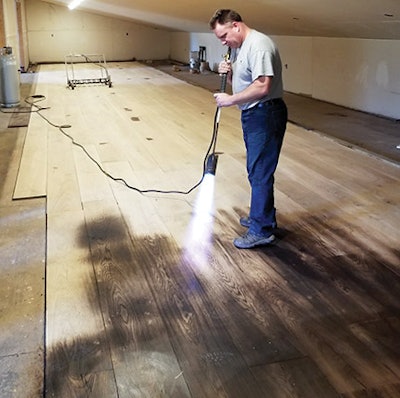 Here my friend Jeff Rose of Newport, Ky.-based Mansion Hill Custom Floors is working on a floor we created together (pictured above). Note that he isn't using my usual firefighter gear and had to go outside on a regular basis to cool off his feet and legs. 'To get that nice even roast with some darker undertones in the softer grains, it's definitely an art form,'' Jeff said after the project was done.
Here my friend Jeff Rose of Newport, Ky.-based Mansion Hill Custom Floors is working on a floor we created together (pictured above). Note that he isn't using my usual firefighter gear and had to go outside on a regular basis to cool off his feet and legs. 'To get that nice even roast with some darker undertones in the softer grains, it's definitely an art form,'' Jeff said after the project was done.
The right customers
Since we charge substantially for this effect (adding at least $5 per square foot to the cost of the flooring), it takes the right customer to choose a shou sugi ban floor. Some customers will ask, "Well, can't you just use a black oil?" The answer is yes, we can, but that's more monochromatic. When something is that heavily pigmented, you lose the depth and chatoyance—the appearance of clarity and depth on the floor. With the roasting process, the wood takes on the color but still looks like wood.
Another factor in selling these floors, or any ultra-high-end wood flooring, for that matter, is the story. Once someone's net worth goes over $50 million, they are more interested in the dinner party story than the product. They want to brag to their friends about how involved they were and how these crazy people were burning their flooring … and then you get the calls from their neighbors. A wood floor like this is a specialty niche that very few other people can reproduce. You can take my sample anywhere you want, but you aren't going to find somebody else to make it for you.
|
Historic Shou Sugi Ban in JapanOne of the most famous examples of shou sugi ban is at the pagoda of the Buddhist temple Horyu-ji in Ikaruga, Japan. The temple is one of the world's oldest existing wood structures and has a shou sugi ban wood exterior believed to date to 711 A.D. |
Shou Sugi Ban Safety EssentialsIt's essential that wherever you do this, you've cleaned up all of your sanding or brushing dust you've made while processing that wood; it can't be anywhere in that environment. Of course we found this out the hard way. When we were first learning, we had a floor laid out in the warehouse, and the guys had done a pretty good job of cleaning up, but there was some dust underneath the flooring in the corner. Well, with the force of the air movement from that flame, the dust immediately ignited, and it created a 3- or 4-foot-diameter fireball. Fortunately no one was injured, but if someone had been standing in that corner I could imagine them getting flash burns. In our warehouse now we have commercial fire extinguishers every 20 feet down the wall. Besides fire, my biggest concern with people attempting these floors is: How are you evacuating the potential carbon monoxide from incomplete combustion? When we do these floors, we have a huge fan probably 6 feet in diameter that came out of an airplane hanger where they would spray airplanes. It's strong enough that you could probably put it on the back of a boat and go through the bayou. We put that in one door on one end and another on the other end, and we're probably dumping every bit of air in that building a couple times a minute. Even so, when we do a heavy burn, I'll wear a respirator so the carbon fumes don't kick my asthma into high gear. |












